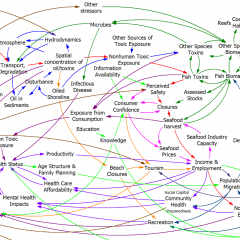Barry Richmond in 1994, describing one of the hazards of archetypes:
The second practice we need to exercise great care in executing is the purveyance of “Systems Archetypes” (Senge, 1990). The care required becomes multiplied several-fold when these archetypes are packaged for consumption via causal loop diagrams. Again, to me, one of the major “problems” with System Dynamics was the “we have a way to get the wisdom, we’ll get it, then we’ll share it with you” orientation. I feel that Systems Thinking should be about helping to build people’s capacity for generating wisdom for themselves. Though I believe that Senge offered the archetypes in this latter spirit, too many people are taking them as “revealed truth,” looking for instances of that truth in their organizations (i.e., engaging in what amounts to a “matching exercise”), and calling this activity Systems Thinking. It isn’t. I have encountered many situations in which the result of pursuing this approach has left people feeling quite disenchanted with what they perceive Systems Thinking to be. This is not a “cheap shot” at Peter. His book has raised the awareness with respect to Systems Thinking for many people around the globe. However, we all need to exercise great caution in the purveyance of Systems Archetypes – in particular when that purveyance makes use of causal loop diagrams.
I’ve seen the problem of the “matching exercise” in classroom settings but not real projects. In practical settings, I do see some utility to the use of archetypes as a compact way to communicate among people familiar with the required systems lingo. In my view the real challenge is that archetypes are underspecified (compared to a simulation model), and therefore ambiguous. You can’t really tell by looking at the structure of a CLD what behavior will emerge. However, if you simulate a model, you might quickly realize, “hey, this is eroding goals” which could convey a whole package of ideas to your systems-aware colleagues.
